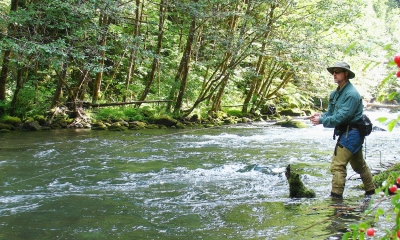
Flatfish
Flatfish start off life looking like any other fry, but as they grow their bodies flatten out and one eye migrates across the fish's face to join the other. At this point the fish tends to swim sideways, looking out for predators and prey up above.

Types of Flatfish

Features: California halibut are usually solid brown to black or mottled with light and dark patches on the eyed side and white underneath. They have the ability to change skin color patterns to blend in with the ocean floor. The eyes on a California halibut are most commonly on the left side but may be on the right side as they are on a Pacific halibut. The upper jaw in a California halibut extends to the rear of the lower eye, while on a Pacific halibut the upper jaw only extends to the front of the lower eye. In both the California and Pacific halibuts the lateral line, which runs along the side of the fish, makes a high arch above the pectoral fin.
Habitat: California halibut spend most of their time buried in sandy bottoms of the ocean floor, but will gladly chase after schools of anchovy. In Oregon, California halibut are rare north of Coos Bay.
Technique: Using live bait fish near the bottom is the way to go if you're targeting a California halibut. A technique called bounce-balling is another way to get this fish's attention.

Features: Starry flounder are a flatfish with both eyes on the "top" side of their heads. They are dark on the eyed side with very rough scales, and alternating yellow/orange and black bands in the dorsal, anal, and tail fins.
Habitat: Flounder tend to stay near the bottom, looking for food above.
Technique: Drift a small jig or bait (such as shrimp, marine worm or mussel) on a #2 hook with 2-ounce sinker rigged on a 10- to 15-pound line over a sandy or muddy bottom.
Header photo by Sam Grover, Flickr
Features: The Pacific sanddab is left-eyed, meaning both eyes are on the left side of the body. The eyed-side is dull light brown, mottled with brown or black, and sometimes yellow or orange. The blind-side is off-white to tan. They have an oval shaped body with large scales. They can grow to be 16-inches long and up to 2 pounds, though most weigh less than 1/3 pound.
Habitat: As you probably guessed, sanddabs like to hang out on sandy bottoms. They are most abundant at depths of 20-50 fathoms, and are common in shallow coastal waters from British Columbia to California.
Technique: Sanddabs are notorious for going after just about anything that crosses their paths. They hunt by scent though so make sure your bait is smelly. Dead bait fish or plastic grubs near the bottom work great when sanddab fishing.

Features: Soles have flattened, oval bodies with both eyes on one side of their head. They are dark on top and light underneath.
Habitat: They are commonly found on mud or sand bottoms from 5- to 750-fathoms deep.
Techniques: Soles and other flatfish are best targeted by fishing with smaller hooks (less than 2/0) tipped with bait such as clam necks, sand shrimp, or chunks of herring or anchovy on a sandy or gravel bottom.

